- Home
- Dick Francis
Lester: The Official Biography Page 19
Lester: The Official Biography Read online
Page 19
Very sore and swollen, the hand was seen at Newmarket by an orthopaedic surgeon who came privately from Cambridge. He didn't know much about racing, he said.
Would Lester please explain when he next wanted to ride.
Immediately, Lester said. Tomorrow. The Derby would occur in two weeks.
The orthopaedic surgeon was of the opinion that the thumb needed three weeks' complete rest, and even then, he warned doubtfully, the tendon might never recover.
He put on some strapping encouragingly, and went away.
Lester continued to ride uninterruptedly and two weeks later won the Derby on The Minstrel. A week later, the orthopaedic surgeon called again at Newmarket to see how the thumb was doing.
"By the way," he said, "I saw you won that race you were so worried about. What was it called?" Lester's thumb never did return to its former shape, though the tendon in the end recovered. His grandfather's hands, he says, were much worse. Ernie Piggott broke his fingers often.
In January 1976, on one of his many winter excursions, Lester fell in the straight in a race in Kuala Lumpur, Malaysia. He was riding a horse called Uncle Ivor (trained in Singapore by his close friend Ivan Allan) which clipped the heels of the horse in front and came down when everyone was going at flat-out speed to the finish.
Lester, tumbled along under the flying hooves, was taken to hospital for checks.
From there, he telephoned to Susan who was in Singapore, saying he might have cracked a rib but was otherwise all right. In the morning, apparently recovered, he went back to the racecourse and rode in the first race.
Finding it too painful to continue, however, he flew to Singapore to join Susan who says he looked "shaken" when he arrived. The next day, Lester consulted a doctor as he was due to fly to New Zealand to ride in the Air New Zealand Cup, and thought his ribs might need strapping. The doctor, after examining him, said dryly that Lester really shouldn't fly anywhere, let alone to New Zealand to race; he had indeed broken not one but two ribs, one of which had punctured his lung. Better, the doctor said, to rest in Singapore for two weeks. Essential, he said, if Lester intended to go on living.
Geoff Lewis, who happened to be in Hong Kong, went to New Zealand in Lester's place, while Lester for once listened to good advice and peacefully mended.
In September 1980, back in England, he fell on his shoulder in September at York. It looked nothing much. It happened just as he passed the winning post, finishing half way back, not engaged with the leaders. His stirrup leather broke just at the instant when he'd stopped riding hard and hadn't begun to pull up. Sooner, or later, he could have managed.
At that moment, though, he was unbalanced and fell off.
He picked himself up slightly embarrassed and seemingly unharmed, but he had damaged the socket of his shoulder and pinched a nerve which for the rest of the season troubled him with shooting pains down his arm.
Bill Tucker had retired and gone to live in Bermuda and was not around to consult.
In addition, strict rules had recently been introduced to prevent jockeys riding when unfit. Medical cards had to be carried and be produced every race day for the racecourse doctor to check. All but minor injuries incurred mandatory lay-offs.
Riding with broken feet was out. Lester kept his shoulder troubles private and before the end of the season had won 156 races in England alone.
The shooting pains continued until November when Lester, happening to be in California with Susan and Maureen, consulted a recommended doctor there. The doctor injected him several times, and the pains subsided.
The affair of Lester's ear at Epsom's Spring Meeting in 1981 was public in the extreme. There had been no cameras at the point where Durtal had dragged him in 1977, but four years later they were steadily focussed on the starting stalls when Lester lined up there on a Thursday afternoon on Winsor Boy for a 5-furlong sprint.
The horses were all in the stalls, excited and keen, the starter on the point of letting them go. Lester was gathering his reins but hadn't yet a firm hold. Winsor Boy, totally without warning, went back, bang, against the closed doors behind him, then dived down to the ground in front. Never before or since, Lester says, has he known a horse to go underneath the gates. Winsor Boy went down and underneath in a flash, taking Lester with him.
In the horse's passage under the still closed gates, Lester's right ear was all but torn off: only a small flap of skin held it on.
Winsor Boy scrambled to his feet, leaving his jockey on the ground, and galloped for two furlongs up the course. Then he swerved left, crashed through the rails and dropped dead of a heart attack, falling unfortunately on a spectator in a wheelchair, who survived.
Lester was told this afterwards. At the time, he lay bleeding on the turf while most people fussed over his ear and he himself-and the racecourse doctor-worried that his back was broken.
"There was so much blood from my ear, but I hardly felt it. My back was worst.
Terrible ... Terrible."
The bottom of the gate had scraped all down the knobs of his backbone and battered his muscles, leaving him in agony and unable to move. In the ambulance on the way to Epsom hospital, he felt more pain than from any other injury ever.
When he arrived at the hospital, his back was immediately X-rayed, and he felt reassured, though not much better, when he was told there were no fractures.
Susan had not been at the racecourse. She heard of the accident by telephone when Dr. Michael Allen, who had been appointed chief racecourse medical officer when the medical cards were introduced, reached her in London. He was kind, Susan says.
He told her that Lester had been transferred to Roehampton Hospital and that they were trying to locate a particular plastic surgeon who worked there, Patrick Whitfield, who was good with almost-severed ears.
By eight in the evening the ear was sewn back in place. Susan slept across two chairs that night by Lester's bedside and the Press began to camp in droves in the corridors downstairs.
Journalists used every ruse they could think of to reach Lester, but he was well guarded by doctors and nurses who repeatedly asked the Press to leave, to no avail.
There's no one as persistent as a journalist whose editor has told him not to come back without a story, particularly when all the editors in London have issued the same orders.
Lester and Susan, wanting to go home quietly, uninterviewed, plotted with one of their friends to create a diversion. The friend arrived in her car at the hospital's front door, loudly announcing she had come to collect Lester. The gentlemen of the Press focussed their cameras and got out their notebooks, and Lester, shuffling, his head heavily bandaged, was smuggled by the nurses out of a back door to be whisked off unseen in a car driven by Susan.
After Bill Tucker retired, Lester had begun being treated by an osteopath, Johnny Johnson, and it was to him that he turned now for repairs. But for Johnny Johnson's frequent assistance, Lester and Susan say, Lester's career might not have lasted so long. He worked that time on the sore backbone and deeply-bruised muscles intensively day after day in London until Lester could again move normally with returning strength.
By the following Tuesday, home in Newmarket, Lester thought it time to get back on a horse: but in case he wasn't as much recovered as he believed, it was decided he should sit only on a pony. A pony was duly borrowed from a small girl (with her entire permission) and to everyone's satisfaction Lester rode it round in an indoor school with no ill effects.
Susan had been to Lillywhites sports shop in London to find something for Lester to wear over his bandaged ear, returning with a red, white and blue woollen headband, originally designed for skiers. Resplendent in this, and equipped with a larger size in helmets, he reappeared on a racecourse six days after the accident, getting his medical card signed to endorse his fitness and riding two horses at Ascot, an also-ran and a second.
On the seventh day, on Fairy Footsteps, he won the One Thousand Guineas.
In August 1984, Lester w
ent to Yarmouth to ride a not-too-brilliant gelding, Royal Octave, in a two-year-old selling race. He was trained by Ben Hanbury who had formerly rented Lester's newlybuilt yard in Newmarket and for whom Lester often rode when asked.
Royal Octave led for a good deal of the way but he produced no finishing speed and was beaten into third place, earning his owner the princely sum of £88.60. Lester pulled him up in the normal way, turned and began to trot back, the reins loose in his hands and lying on the horse's neck. Something abruptly scared him at that point and he shied violently, whipping round in a 180-degree turn, flinging Lester out sideways.
Lester's foot, as before with Durtal, went through the stirrup iron, and Royal Octave, already alarmed, set off at a renewed gallop with Lester hanging helplessly by his caught ankle. For a good fifty yards, he dragged him along the hard ground, his hind feet thudding into him repeatedly while he tried frantically to free his foot. Again ... again ... he thought he would be killed.
He saved himself. He survived not by getting his foot back through the stirrup, but by pulling his foot out of his boot. He fell free, badly battered, while the gelding hurtled onwards until his panic died. There was no chance that time that, after a cup of tea, Lester would be riding in the next race as one of the horse's kicks had damaged his hip, knocking a chunk off the top of his femur. Jockeys' bones, as one can see, are close to the surface under the skin.
Lester went home for a good deal of treatment from Johnny Johnson and also from two devoted physiotherapists in Newmarket, Fiona Morton and her partner Barbara.
Lester particularly wants to thank those two and their assistants for all their help, acknowledging that he owed to them his comparatively fast return to the saddle.
It was on 8 August that Royal Octave dragged him. On 1 September, he returned with a winner ... a 6-4 favourite two-year-old, Oh So Sharp.
Within five weeks, but not until after he'd won the St. Leger on Commanche Run, Kanz, trained by Guy Harwood, clipped the heels of a runner in front and fell with him two furlongs from the start of the Sun Chariot Stakes at Newmarket. Lester rolled over in several somersaults owing to the fast speed, and was helped to his feet by a doctor following the field with an ambulance. The doctor put in a report that Lester had appeared dazed after his fall, and Dr. Allen had no choice but to act on this and require Lester not to race again for two days.
Two days might not normally matter, but this fall occurred on a Saturday afternoon, and the Prix de 1'Arc de Triomphe was on the next day, Sunday.
When Dr. Allen insisted Lester miss the Arc, Lester thoroughly lost his temper. He asked Dr. Allen to examine his (Lester's) eyes, which he did: there was no sign of concussion. Dr. Allen all the same said he couldn't overthrow the judgment of his colleague. -Lester, who had raced with double vision, with a broken foot, a punctured lung and a kidney stone, who had struggled back countless times with half-healed hurts, was totally furious at being stood down when he felt all right.
Susan, alerted at home by telephone, drove along to the racecourse and went to the first-aid room, and there found her husband covered in mud, blazing with anger, arguing strongly and looking anything, she says, but dazed.
There was nothing to be done. No possibility of appeal. Lester and Susan went home, she to telephone pleadingly to a neurologist who said that even if Lester was completely all right-and who wouldn't be dazed for a second or two after somersaulting from a horse at thirty-five miles an hour-even if, he too couldn't overthrow the opinion of a colleague.
Lester had been going to ride Rainbow Quest for Jeremy Tree in the Arc but his disappointment could have been worse. Until a day earlier, his intended mount had been the great Teenoso on whom he won the 1983 Derby, but an old injury of Teenoso's had flared up, causing him to be withdrawn at the last minute. The offer of Rainbow Quest had been a bonus and a consolation. In the event, ridden instead by Tony Murray, the colt finished way back; and if Lester had been on his back, it might well have been said that Lester shouldn't have been allowed to ride after his fall.
(Ironically, Rainbow Quest won the Arc-on an objection-in 1985, ridden this time by Pat Eddery.)
The odd thing, Lester says now with a smile, was that in all the fuss at Newmarket over whether or not he was dazed, no one noticed the thing that was actually wrong.
The thumb he had injured before was in the wars again, and his whole hand was numb. "I stood there arguing with Dr. Allen," Lester says, "and I couldn't feel my hand at all. But if he had let me ride ... I could have ridden like that." And after all else, one has to believe it.
He worked on his numb hand all evening, until the feeling gradually came back, and concedes now that two days' rest didn't do him much harm.
In spite of his fury on that occasion, he does think the modern medical rules are fairly sensible. It is mostly for head injuries that compulsory rest periods are imposed: two days for dizziness and a week for a simple knock-out are normal. A whole lot of punch-drunk jockeys, so the thinking goes, would do the industry no good.
Dr. Michael Allen is in fact a thoroughly pleasant and humane man walking a difficult tightrope, with fiercely indignant jockeys on the one hand and the interests of owners, trainers, punters and the Injured Jockeys Fund on the other.
Lester, who hid his worst injuries better than most, has no disabilities or lasting effects today.
-
20 Trainers
"GOOD trainers are good to ride for. Bad trainers make good horses bad. The best trainers make the easy things look easy," Lester said.
"Don't you mean," I asked mildly, "that the best trainers make the difficult things look easy?" No, Lester didn't. Bad trainers, he said, make the easy things look difficult. "Some trainers make their horses stupid. They rush them and don't give them a chance to learn good manners, because they can't afford to pay people to teach them. A good trainer's horses are always better rides."
He must have ridden for more trainers than any other jockey, and he sees the differences between them as mostly in the trainers' own personalities, not in the fitness of their charges. Most trainers can turn out a reasonably fit horse: if they couldn't, they'd be out of business. Success lies in unmeasurable things like commonsense, imagination, patience and flair.
Of the trainers Lester rode for most significantly, the first (except for his father) were Frank and Ken Cundell. Frank and his cousin Ken were, as young men, joint assistants to their uncle, Leonard Cundell, who trained in the racing village (then Berkshire, now Oxfordshire) of Aston Tirrold. Returning from the Second World War, Frank took over Leonard's yard while Ken set up on his own, ten miles away at Compton in Berkshire.
I myself (Dick Francis) rode jumpers for both cousins for many years, especially for Frank after Ken had turned more and more to the Flat. Frank, who trained Zina for the 1950 Cambridgeshire, later concentrated on jumpers, and I rode for him until I retired in 1957. He was a great friend, whose death in 1983 the whole racing world mourned.
For four years from 1949, I rented from Ken a house which looked out into his yard.
I rode his horses at morning exercise, raced them in the afternoons and acted for him in any capacity I could. One can say that I knew him well, and we have remained friends ever since. Retired now, he is kind and generous, with forthright views unhesitatingly expressed.
When Lester was still a smallish bundle of raw fourteen-year-old talent, Ken was heard regularly saying, "That boy is going to be the greatest jockey who ever lived, mark my words," and, thirty-six years later, beaming with pleasure, he finishes the sentence, "and I was right."
Back in 1950, he saw the talent clearly and, knowing Keith Piggott well, had no trouble in engaging his son.
It was Ken, training Zucchero, who gave Lester at fifteen his first ride in the Derby.
Zucchero represented Ken's first and best chance of winning the most prestigious race in the world, and for him to have chosen a semi-child as a jockey was a remarkable proof of his faith.
The wayward
ly brilliant colt came into Ken's yard because his owner, Charles Stuart, grown sick of the two-year-old's infuriating habit of refusing to start, offered him to his bookmaker, George Rolls, to clear a debt of £800. George Rolls relayed this to Ken, who happened to be there in the Rolls office when the offer was made by telephone. "You take Zucchero," Ken said at once, "and I'll make him start"; and so the bargain was struck.
Ken was usually successful in the matter of starting (seepage 40) but Zucchero was too moody for his own good. "He used to sulk," Ken says. "I could feel him sulking just before the Derby. They had to walk in towards the tapes twice before the starter let them go, and Zucchero didn't like it."
One evening later in the year, when Ken was in the colt's box, Zucchero tried to bite him. Ken, infuriated, took hold of his head-collar and punched Zucchero hard in the ribs. "I punched him several times as hard as I could. I fought him ... and he behaved better to me after. A difficult horse, but he was never so much trouble after that."

 Bolt
Bolt Proof
Proof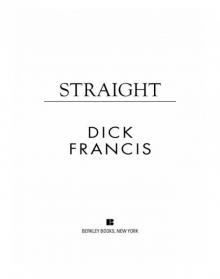 Straight
Straight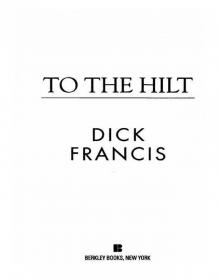 To the Hilt
To the Hilt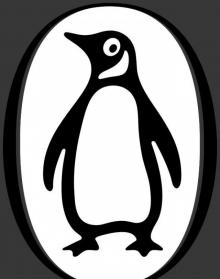 High Stakes
High Stakes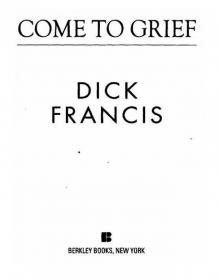 Come to Grief
Come to Grief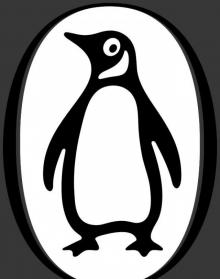 Odds Against
Odds Against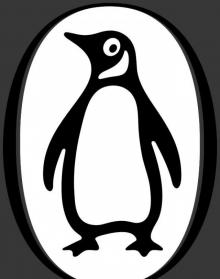 Knock Down
Knock Down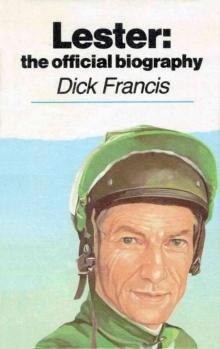 Lester: The Official Biography
Lester: The Official Biography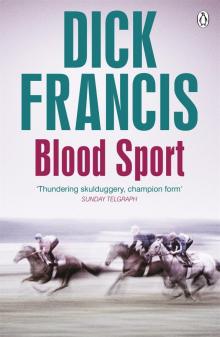 Blood Sport
Blood Sport Trial Run
Trial Run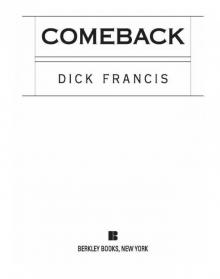 Comeback
Comeback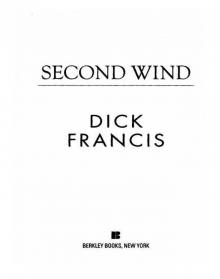 Second Wind
Second Wind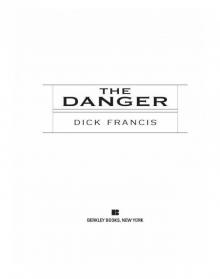 The Danger
The Danger Under Orders sh-4
Under Orders sh-4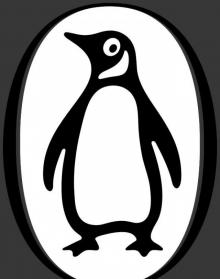 Break In
Break In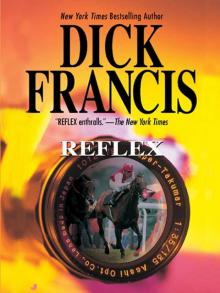 Reflex
Reflex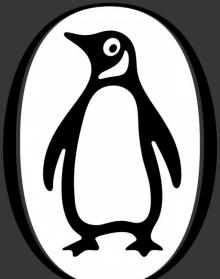 Dead Heat
Dead Heat Dick Francis's Damage
Dick Francis's Damage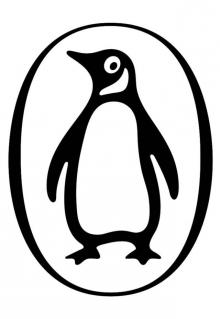 The Edge
The Edge Wild Horses
Wild Horses Longshot
Longshot Slay Ride
Slay Ride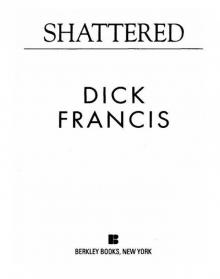 Shattered
Shattered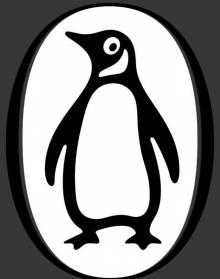 Banker
Banker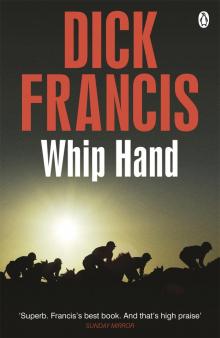 Whip Hand
Whip Hand Even Money
Even Money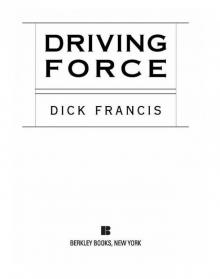 Driving Force
Driving Force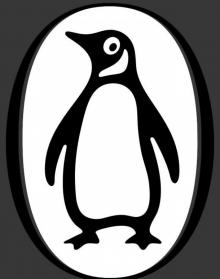 Decider
Decider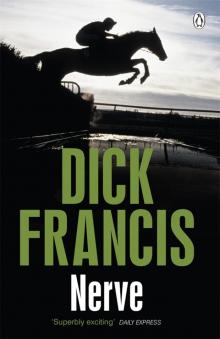 Nerve
Nerve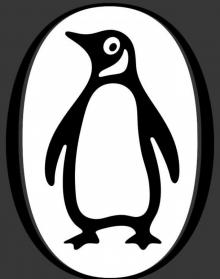 Hot Money
Hot Money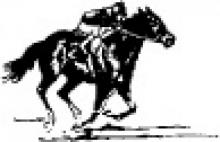 Field of Thirteen
Field of Thirteen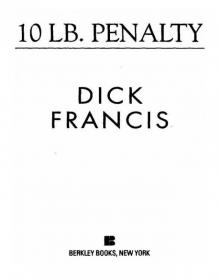 10 lb Penalty
10 lb Penalty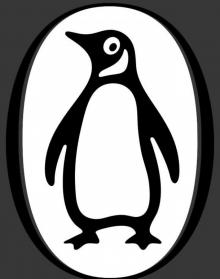 Dead Cert
Dead Cert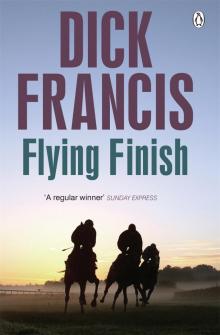 Flying Finish
Flying Finish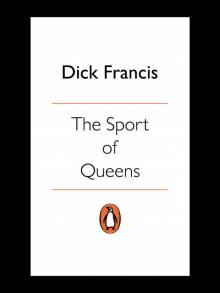 The Sport of Queens
The Sport of Queens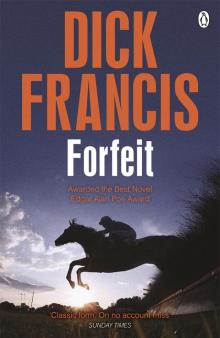 Forfeit
Forfeit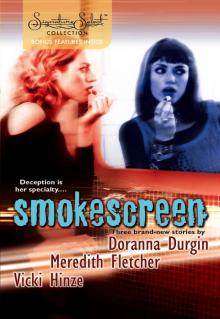 Smokescreen
Smokescreen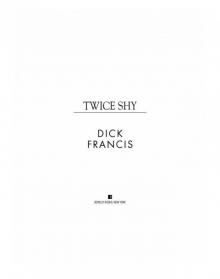 Twice Shy
Twice Shy Silks
Silks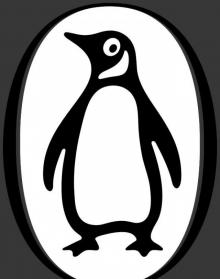 Enquiry
Enquiry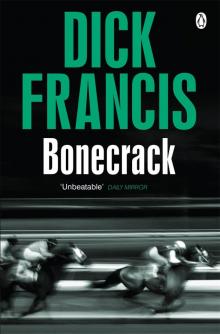 Bonecrack
Bonecrack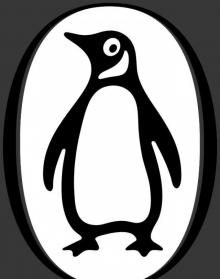 For Kicks
For Kicks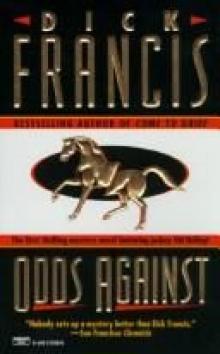 Odds against sh-1
Odds against sh-1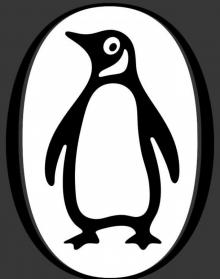 Rat Race
Rat Race Crossfire
Crossfire